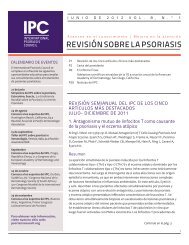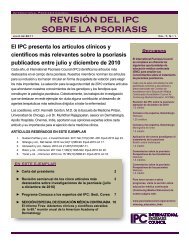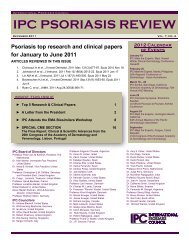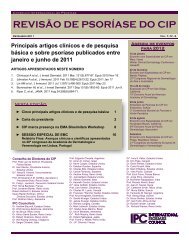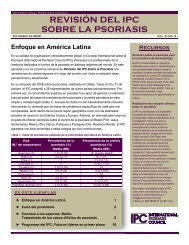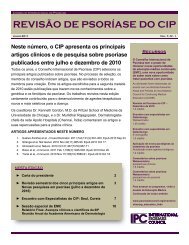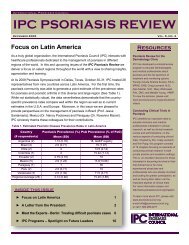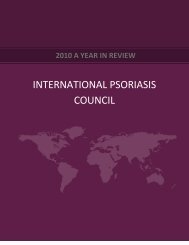September 2009 - International Psoriasis Council
September 2009 - International Psoriasis Council
September 2009 - International Psoriasis Council
Create successful ePaper yourself
Turn your PDF publications into a flip-book with our unique Google optimized e-Paper software.
I NTERNATIONAL P SORIASIS C OUNCIL<br />
IPC PSORIASIS REVIEW<br />
<strong>September</strong> <strong>2009</strong> Vol. 5, No. 2<br />
IPC presents the most relevant<br />
psoriasis clinical and research articles<br />
Each year, the <strong>International</strong> <strong>Psoriasis</strong> <strong>Council</strong> (IPC) identifies the top papers in the<br />
field of psoriasis. Papers are nominated for inclusion by our Board of Directors and<br />
then circulated to our membership to identify the most important papers. This year’s<br />
selection includes articles that: further our understanding of the genetic basis of<br />
psoriasis in multiple populations; delineate key mediators of psoriatic disease<br />
pathogenesis such as -defensins, interleukin (IL)-20, and IL-22; describe clinical<br />
research on a new class of drugs that target the IL-12 and IL-23 pathways; and<br />
present a longitudinal analysis of comorbid cardiovascular diseases subsequent to<br />
psoriasis diagnosis.<br />
Co-editors Professor Ricardo Romiti, Department of Dermatology, University of São<br />
Paulo, Brazil; and Professor Errol Prens, Department of Dermatology, Erasmus<br />
University Medical Center, Rotterdam, The Netherlands, provided expert<br />
commentary on each article and its value to clinical practice.<br />
ARTICLES REVIEWED IN THIS ISSUE<br />
JANSEN, ET AL. PLOS ONE. <strong>2009</strong> 4(3):e4725.<br />
GOTTLIEB, ET AL. LANCET. <strong>2009</strong> FEB;373(9664):633-40.<br />
NAIR, ET AL. NAT GENET. <strong>2009</strong> FEB;41(2):199-204.<br />
NOGRALES, ET AL. BR J DERMATOL. 2008 NOV;159(5):1092-102.<br />
WOLK, ET AL. J MOL MED. <strong>2009</strong> MAY;87(5):523-36.<br />
KRYCZEK, ET AL. J IMMUNOL. 2008 OCT;181(7):4733-41.<br />
DE CID, ET AL. NAT GENET. <strong>2009</strong> FEB;41(2):211-5.<br />
GELFAND, ET AL. J INVEST DERMATOL. <strong>2009</strong> MAY 21; ONLINE PUBLICATION.<br />
ZHANG, ET AL. NAT GENET. <strong>2009</strong> FEB;41(2):205-10.<br />
KAYE, ET AL. BR J DERMATOL. 2008 SEP;159(4):895-902.<br />
Review of articles begins on page 3.<br />
Calendar<br />
Meet the Experts Berlin<br />
The <strong>International</strong> <strong>Psoriasis</strong> <strong>Council</strong><br />
invites medical professionals to a<br />
case-based learning forum on difficultto-treat<br />
psoriasis cases.<br />
8 October <strong>2009</strong><br />
17:00 – 18:00<br />
18th EADV Congress<br />
<strong>International</strong>es Congress<br />
Centrum Berlin<br />
Berlin, Germany<br />
Chairman<br />
Wolfram Sterry, M.D.<br />
Berlin, Germany<br />
Panelists<br />
Jonathan Barker, M.D.<br />
London, UK<br />
Alan Menter, M.D.<br />
Dallas, USA<br />
Peter van de Kerkhof, M.D., Ph.D.,<br />
Nijmegen, The Netherlands<br />
For more information about events, visit:<br />
www.psoriasiscouncil.org/events<br />
To learn more about IPC,<br />
visit www.psoriasiscouncil.org,<br />
e-mail info@psoriasiscouncil.org,<br />
or call 800.289.0277<br />
INSIDE THIS ISSUE<br />
► A letter from the President 2<br />
► Annual review of top research papers 3<br />
► Meet the Experts: Treating difficult psoriasis cases 8
A letter from the president<br />
Dear Colleagues,<br />
On behalf of the <strong>International</strong> <strong>Psoriasis</strong> <strong>Council</strong> (IPC) and this<br />
issue’s co-editors Profs Ricardo Romiti and Errol Prens, I am<br />
delighted to introduce the <strong>September</strong> <strong>2009</strong> edition of our IPC<br />
<strong>Psoriasis</strong> Review. A big thank you to Professors Romiti and<br />
Prens for all their efforts.<br />
Published several times per year, IPC <strong>Psoriasis</strong> Review<br />
appraises important current clinical and research publications and<br />
provides commentary on those that we believe make the broadest<br />
contribution to our understanding of the disease and its treatment.<br />
It is certainly not an easy task to choose 10 “top papers” from the<br />
wide range of quality papers published in the Scientific, Medical<br />
and Dermatology literature each year. I very much appreciate my<br />
colleagues on the Board of the IPC helping do a thorough review<br />
of the literature and contributing to the choice.<br />
We also present select cases from our June 27, <strong>2009</strong>, 2 nd World<br />
<strong>Psoriasis</strong> & Psoriatic Arthritis Conference IPC Meet the Experts<br />
Program, chaired by Professor Jonathan Barker, and held in<br />
Stockholm.<br />
In <strong>2009</strong>, IPC has continued to expand its mission to enhance<br />
research, education and innovation in the diverse areas of<br />
psoriasis. This has included the initiation of an important<br />
Pediatric Registry Program and the conclusion of a rigorous 200-<br />
patient Outcomes Measure Study currently under statistical<br />
review by James Krueger’s department at Rockefeller University<br />
in New York, as well as the introduction of a mentoring program<br />
for four young residents in the USA soon to expand to Europe.<br />
<strong>2009</strong> was also time for change within IPC as Liz Horn transitioned<br />
out of her role as Director of Medical and Scientific Affairs to seek<br />
new career opportunities. We wish Liz all the best in her future<br />
endeavors and express our sincere gratitude for her assiduous<br />
efforts in creating and extending the Medical and Scientific<br />
mission of IPC. As a consequence, we also welcome Paul<br />
Tebbey as our interim Vice-President of Medical and Scientific<br />
Affairs. Paul brings broad and valuable experiences, both<br />
academic and industrial, that will be a great asset as we expand<br />
and enhance IPC’s Medical and Scientific purpose. Many of you<br />
already know Paul from his days in dermatology at Centocor<br />
where he played an integral role in the development of<br />
ustekinumab. With a background of both a Ph.D. and a MBA, I<br />
am very confident that you will all enjoy re-engaging with Paul on<br />
his return to the field of Dermatology and particularly <strong>Psoriasis</strong>.<br />
He certainly brings a wealth of experience, knowledge and<br />
enthusiasm to IPC.<br />
I am also saddened to report the loss of a member of our own<br />
IPC community, Dr Seija-Liisa Karvonen of the Department of<br />
Dermatology, University Hospital of Oulu, Finland. She passed<br />
away in August after a long battle with pancreatic cancer. Our<br />
sincerest sympathies are extended to her family, colleagues and<br />
friends. We at IPC all recognize her significant contributions to<br />
the field of <strong>Psoriasis</strong>.<br />
We hope this newsletter is informative and that the knowledge,<br />
experience and insights of our faculty are valuable to you in<br />
evaluating and treating your psoriasis patients. For additional<br />
copies of IPC <strong>Psoriasis</strong> Review, or to learn more about IPC,<br />
please visit www.psoriasiscouncil.org.<br />
Sincerely,<br />
Alan Menter, M.D., President<br />
<strong>International</strong> <strong>Psoriasis</strong> <strong>Council</strong><br />
IPC Board of Directors<br />
Professor Jonathan Barker, United Kingdom<br />
Professor Christopher E.M. Griffiths, Honorary<br />
Secretary, United Kingdom<br />
Robert Holland III, United States<br />
Dr. Craig L. Leonardi, Honorary Treasurer, United States<br />
Ms. Malia Tee Lewin, United States<br />
Dr. Alan Menter, President, United States<br />
Karen Baxter Rodman, United States, CEO & Executive<br />
Director<br />
Professor Wolfram Sterry, Germany<br />
Professor Peter van de Kerkhof, The Netherlands<br />
Ms. Melodie Young, United States<br />
IPC <strong>Council</strong>ors*<br />
Professor Hervé Bachelez, France<br />
Dr. Ian Bruce, United Kingdom<br />
Dr. Wai-Kwong Cheong, Singapore<br />
Professor Andrew Finlay, United Kingdom<br />
Professor Alberto Giannetti, Italy<br />
Dr. Alice Gottlieb, United States<br />
2 IPC <strong>Psoriasis</strong> Review<br />
Dr. Gerald G. Krueger, United States<br />
Dr. James G. Krueger, United States<br />
Dr. Gladys Aires Martins, Brazil<br />
Dr. Hidemi Nakagawa, Japan<br />
Professor Jean-Paul Ortonne, France<br />
Dr. Kim Alexander Papp, Canada<br />
Professor Errol Prens, The Netherlands<br />
Professor Jean-Hilaire Saurat, Switzerland<br />
Dr. Fernando Stengel, Argentina<br />
Professor John Sullivan, Australia<br />
Dr. Gail Todd, South Africa<br />
* IPC has chosen to honor these members<br />
with the title of “councilor” to acknowledge<br />
their special contributions to psoriasis.<br />
IPC Members<br />
Dr. Wolf-Henning Boehncke, Germay<br />
Dr. Robert J. G. Chalmers, United Kingdom<br />
Professor Sergio Chimenti, Italy<br />
Professor Edgardo Chouela, Argentina<br />
Professor Kevin D. Cooper, United States<br />
Professor Esteban Dauden, Spain<br />
Professor Charles N. Ellis, United States<br />
Professor Carlos Ferrandiz, Spain<br />
Dr. Kenneth Gordon, United States<br />
Dr. Lars Iversen, Denmark<br />
Dr. Seija-Liisa Karvonen, Finland**<br />
Dr. Alexa B. Kimball, United States<br />
Dr. Richard G. Langley, Canada<br />
Dr. Mark Lebwohl, United States<br />
Dr. Ulrich Mrowietz, Germany<br />
Dr. Frank O. Nestle, United Kingdom<br />
Dr. David M. Pariser, United States<br />
Dr. Carlo Pincelli, Italy<br />
Dr. Mark R. Pittelkow, United States<br />
Professor Jörg Prinz, Germany<br />
Professor Ricardo Romiti, Brazil<br />
Professor Mona Ståhle, Sweden<br />
Dr. Bruce Strober, United States<br />
** In memoriam
Top 10 Clinical Research Papers<br />
PRESENTING SUMMARIES AND COMMENTARY<br />
<br />
-Defensin-2 protein is a serum biomarker for disease activity in psoriasis and reaches<br />
biologically relevant concentrations in lesional skin<br />
In this article, Jansen et al connect previous genetic associations with the biological activity of beta-defensin-2 (hBD-2) in<br />
psoriasis patients in vivo. By determining that systemic levels of hBD-2 were correlated with beta defensin copy number<br />
and by measuring the systemic protein levels of hBD-2 in psoriatics, the authors were able to contribute a potentially<br />
reliable serum biomarker unique to psoriasis disease activity and notably absent in other inflammation-based disease<br />
states such as rheumatoid arthritis (RA). Other beta-defensins such as hBD-1 and hBD-3 were equally up regulated in<br />
RA and atopic dermatitis.<br />
Jansen PA, Rodijk-Olthuis D, Hollox EJ, Kamsteeg M, Tjabringa GS, de Jongh GJ, van Vlijmen-Willems IM, Bergboer JG, van Rossum MM,<br />
de Jong EM, den Heijer M, Evers AW, Bergers M, Armour JA, Zeeuwen PL, Schalkwijk J. Beta-defensin-2 protein is a serum biomarker for<br />
disease activity in psoriasis and reaches biologically relevant concentrations in lesional skin. PLoS ONE. <strong>2009</strong>;4(3):e4725.<br />
COMMENTARY<br />
Evidence is permitting a clearer focus on the genetic and pathophysiological underpinnings of psoriasis. Consequently, hBD-2,<br />
contained within the beta defensin cluster on chromosome 8, is a strong candidate gene for psoriasis. This analysis correlated<br />
both copy number and specific gene expression levels to disease severity, suggesting that psoriasis has multiple underlying<br />
factors, both genetic and regulatory in nature, that potentially contribute to the phenotype of the disease. It is of relevance to us in<br />
dermatology that hBD-2 protein is not up regulated in another important inflammatory condition, i.e. atopic dermatitis.<br />
2. Clinical evidence of a role for IL-12 and IL-23 in psoriatic arthritis<br />
In this paper, Gottlieb et al tested the notion that the interleukins 12 and 23 were involved in the pathogenesis of the joint<br />
disease, psoriatic arthritis. By utilizing the human monoclonal antibody, ustekinumab, which inhibits receptor binding of<br />
these two cytokines, the authors were able to quantify the impact on both clinical symptoms and pathological joint<br />
changes. In the phase II trial that involved 146 patients from sites in North America and Europe, the authors tested two<br />
doses of ustekinumab (90 mg and 63 mg) administered every week for 4 weeks prior to the primary endpoint at week 12.<br />
The results were presented in an intent-to-treat format, and showed statistically superior responses in the ACR 20 scores<br />
of patients that received ustekinumab (combined doses, 42%) versus placebo (14%). Adverse events were similar in both<br />
groups with 61% in the drug treated groups reporting an AE versus 63% in placebo. At the week 12 primary endpoint,<br />
three serious adverse events were reported in the placebo group, with none being reported in patients that received<br />
ustekinumab. Thus, the authors concluded that ustekinumab was well tolerated and significantly reduced signs and<br />
symptoms of psoriatic arthritis compared with placebo.<br />
Gottlieb A, Menter A, Mendelsohn A, Shen YK, Li S, Guzzo C, Fretzin S, Kunynetz R, Kavanaugh A. Ustekinumab, a human interleukin 12/23<br />
monoclonal antibody, for psoriatic arthritis: randomised, double-blind, placebo-controlled, crossover trial. Lancet. <strong>2009</strong> Feb 21;373(9664):633-40.<br />
COMMENTARY<br />
This is the first report of a positive clinical impact by an agent that targets IL-12 and IL-23 in joint disease. The data therefore build<br />
upon the impressive results that ustekinumab has demonstrated in the treatment of psoriasis. New treatment options are needed<br />
for patients with both skin and joint disease but who do not respond to standard available agents, such as the anti-TNF class of<br />
therapies. Particular aspects of the trial are interesting; first, the drug achieved impressive ACR 20 scores in patients that can be<br />
considered less severe than those included in previous Psoriatic Arthritis trials; and second, the longevity of the symptomatic<br />
response to ustekinumab was remarkably persistent, even out to 36 weeks after only four doses that ended at week 3.<br />
Biologically, these data also validate a role for IL-12/ 23 in the pathogenesis of psoriatic arthritis, if not overall joint disease, which<br />
had been controversial. Evolving knowledge of IL-23 and its stimulation of IL-17 reveals a possible answer, since it has been<br />
suggested that IL-17 plays a part in bone destruction mechanisms of arthritis. Yet to be elucidated is whether IL-12/23 impacts<br />
psoriatic diseases via a different pathogenic pathway than the more broadly studied TNF-.<br />
<strong>September</strong> <strong>2009</strong> 3
Top 10 Clinical & Research Papers<br />
3 Novel <strong>Psoriasis</strong> Susceptibility Loci<br />
To further the case for establishing genetic polymorphism as a contributor to psoriasis, Nair et al worked with the Genetic<br />
Association Information Network (GAIN) to compare over 1,400 psoriasis patients with over 1,400 matched controls. In<br />
total, over 438,000 single nucleotide polymorphisms (SNPs) were analyzed to select for those genetic differences that<br />
were more frequently associated with psoriasis. Twenty-one of the genetic variants that displayed association with<br />
psoriasis were subsequently tested in a cohort of over 5,000 psoriasis patients and more than 5,000 controls. The results<br />
highlight the role of several key pathways in disease susceptibility and validate the association of psoriasis with genetic<br />
mutations in HLA-C, part of the human immune system’s major histocompatability complex that controls identification of<br />
self from non-self, as well as mutations in the genes for subunit A of the cytokine IL-23 and the IL-23 receptor. Moreover,<br />
the analysis has identified several new loci potentially associated with psoriasis including two genes that act downstream<br />
of TNF- and regulate NF-B signaling (TNIP1, TNFAIP3) and two genes involved in the modulation of Th2 immune<br />
responses (IL-4, IL-13). The authors further demonstrated differences in the protein expression of these genes by<br />
comparing biopsies from psoriasis-involved and uninvolved skin. The results contribute to the knowledge regarding a<br />
genetic basis for psoriasis.<br />
Nair RP, Duffin KC, Helms C, Ding J, Stuart PE, Goldgar D, Gudjonsson JE, Li Y, Tejasvi T, Feng BJ, Ruether A, Schreiber S, Weichenthal M,<br />
Gladman D, Rahman P, Schrodi SJ, Prahalad S, Guthery SL, Fischer J, Liao W, Kwok PY, Menter A, Lathrop GM, Wise CA, Begovich AB,<br />
Voorhees JJ, Elder JT, Krueger GG, Bowcock AM, Abecasis GR; Collaborative Association Study of <strong>Psoriasis</strong>. Genome-wide scan reveals<br />
association of psoriasis with IL-23 and NF-kappa B pathways. Nat Genet. <strong>2009</strong> Feb;41(2):199-204.<br />
COMMENTARY<br />
Genetic analyses are a powerful mechanism to identify potential therapeutic targets for psoriasis. Of interest in this analysis is that at least five of the targets<br />
point to mutations in the signaling pathways for TNF and IL-23. Indeed, clinical trial study of biologic therapies with specificity to the cytokines, TNF and<br />
IL-23 have proven to be very effective in ameliorating the effects of psoriasis. However, these genetic data extend the repertoire of potential targets that<br />
might impair normal cell signaling thus leading to the inflammatory condition, and that should prove valuable in the development of new clinical approaches.<br />
But the authors are also clear to point out that the strength of the association of these genetic loci with psoriasis does not explain the observed incidence of<br />
psoriasis in siblings. Similarly, a lack in association signal strength for psoriasis and psoriatic arthritis was also noted. Taken together, these observations<br />
suggest that while we have defined some very important genetic underpinnings of psoriasis, there is much more work to be done.<br />
4. Evaluating differential roles of Th17-derived cytokines<br />
Th17 cells have received much attention in terms of their relevance in psoriasis pathogenesis. Now, Nograles et al<br />
investigated the cytokines produced by skin-resident T cells in normal skin, and further identified the receptors for these<br />
cytokines. The authors also examined how cytokines alter gene expression profiles of the cells bearing cognate<br />
receptors. By using a variety of intracellular techniques to localize cytokines and immunohistochemistry to map cellular<br />
phenotypes in the skin, they were able to demonstrate that the Th17-derived cytokines IL-17 and IL-22 mediate distinct<br />
downstream pathways. IL-17 is suggested to be more proinflammatory, while IL-22 retards keratinocyte differentiation<br />
thus fueling hyperproliferation.<br />
Nograles KE, Zaba LC, Guttman-Yassky E, Fuentes-Duculan J, Suárez-Fariñas M, Cardinale I, Khatcherian A, Gonzalez J, Pierson KC, White<br />
TR, Pensabene C, Coats I, Novitskaya I, Lowes MA, Krueger JG. Th17 cytokines interleukin (IL)-17 and IL-22 modulate distinct inflammatory<br />
and keratinocyte-response pathways. Br J Dermatol. 2008 Nov;159(5):1092-102.<br />
COMMENTARY<br />
Networks of cytokines have been theorized to be central to the proinflammatory condition that results in psoriasis, but dissecting the individual roles for each<br />
component has proven to be very difficult. By using a unique technique of cytokine staining and flow cytometry to evaluate T cell cytokine production and<br />
immunohistochemistry and double-label immunofluorescence to localize cytokine receptors in skin, the authors were able to co-localize different cytokines to<br />
specific cells thus providing an explanation for their roles. Similar to the results presented by Wolk et al (page 5) these authors also found that IL-22<br />
regulated the expression of keratinocyte mobility and terminal differentiation. Moreover, IL-17 induced neutrophilic granulocyte-attracting chemokines and<br />
CCL20 and demonstrated enhanced expression of these mediators in lesional skin compared to nonlesional skin from psoriasis patients. This paper<br />
confirms the view that a number of genes up regulated in psoriasis lesions can be attributable to IFN-, further showing that other cytokines (IL-17 and IL-22)<br />
can regulate other sets of psoriasis-related genes. It is the collective impact of both IL-17 and IL-22 that might explain the pathogenic effect during<br />
inflammation, contributing to the combined influx of neutrophils, memory T cells and DCs, and delaying keratinocyte differentiation, respectively. Thus, a<br />
new model for differential cytokine involvement in psoriasis is born that is based upon the activation of multiple independent pathways.<br />
4 IPC <strong>Psoriasis</strong> Review
Top 10 Clinical & Research Papers<br />
5. IL-22 and IL-20 are key mediators in the distal stage of psoriasis pathogenesis that<br />
involves psoriatic epidermis alterations<br />
By over-expressing IL-22 in transgenic mice, Wolk et al have defined a potential role for IL-20 and IL-22 in the epidermal<br />
alterations leading to psoriasis, but seemingly have precluded an impact by either IL-17 or IFN-. This is because the IL-<br />
22 overexpression was sufficient to cause psoriasis-like skin alterations as well as neonatal mortality. Furthermore, the<br />
IL-22 gene upregulation was specific to keratinocytes, as similar effects were not seen in other cell types; skin fibroblasts,<br />
endothelial cells, melanocytes, or adipocytes. The IL-22 effect on differentiation-regulating genes was also found to be<br />
STAT3-dependent. In addition to IL-22, IL-20 demonstrated similar effects but of lower comparative potency, and TNF<br />
was found to amplify some of the effects of IL-22 when present in combination. However, while IFN- and IL-17 strongly<br />
induced T-cell and neutrophilic granulocyte-attracting chemokines, respectively, they did not result in psoriasis-like<br />
morphological changes. This study suggests that while different cytokines may be players in psoriasis pathogenesis, it is<br />
IL-22 and IL-20 that are key to the characteristic epidermal alteration.<br />
Wolk K, Haugen HS, Xu W, Witte E, Waggie K, Anderson M, Vom Baur E, Witte K, Warszawska K, Philipp S, Johnson-Leger C, Volk HD, Sterry W, Sabat<br />
R. IL-22 and IL-20 are key mediators of the epidermal alterations in psoriasis while IL-17 and IFN-gamma are not. J Mol Med. <strong>2009</strong> May;87(5):523-36.<br />
COMMENTARY<br />
This paper contributes to the rapidly evolving knowledge of the key cytokines involved in the pathogenesis of psoriasis, and thereby<br />
identifies potential new therapeutic targets that can more selectively regulate the disease. In this case the authors propose to target<br />
IL-22R1 as a mechanism to prevent the action of both IL-22 and IL-20, both members of the IL-10 family of cytokines and which<br />
therefore bind to shared receptors. Moreover, keratinocytes appear to be the only cells that express IL-22R1 in the skin, providing<br />
some unique selectivity to potential therapeutic agents. Especially when compared to pluripotent TNFα, the blockade of IL-22R1 may<br />
induce fewer systemic side-effects, although the repercussion of this specific blockage on skin homeostasis remains unknown.<br />
6. Orchestrating psoriasis: elucidating the complex roles for different cytokines and cell<br />
subsets that populate the psoriatic lesion<br />
In this report, Kryczek et al explore the phenotype and function of IL-17-secreting T cells in psoriatic skin, and investigate<br />
the factors supporting their trafficking to and subsequent induction that leads to the manifestation of the psoriatic lesion.<br />
Specifically, the data show that IFN- may promote trafficking, induction, and function of IL-17+ T cells in people with<br />
psoriasis, a view that challenges previous theories wherein Th1 cells were thought to suppress Th17 cell development.<br />
Increased numbers of CD4+ IL-17+ and CD8+ IL-17+ T cells were measured in skin lesions of psoriasis patients. Using<br />
T-cell culture systems, myeloid antigen-presenting cells (APC) were found to respond to the Th1 cytokine, IFN-, thus<br />
triggering the induction of IL-1 and IL-23 resulting in the stimulation of IL-17+ T cells. To define the mechanism by which<br />
these activated T cells trafficked to the skin, the investigators took advantage of a transwell migration system. In this<br />
assay, activated CD4+ IL-17+ and CD8+ IL-17+ T cells were found to traffic toward CCL20, the ligand for the CCR6<br />
chemokine receptor found on the surface of the IL-17+ T cells. Moreover, it was discovered that such trafficking was IFN-<br />
-dependent, thus placing this Th1 cytokine as the conductor of the resultant psoriatic lesion.<br />
Kryczek I, Bruce AT, Gudjonsson JE, Johnston A, Aphale A, Vatan L, Szeliga W, Wang Y, Liu Y, Welling TH, Elder JT, Zou W. Induction of IL-17+<br />
T cell trafficking and development by IFN-gamma: mechanism and pathological relevance in psoriasis. J Immunol. 2008 Oct 1;181(7):4733-41.<br />
COMMENTARY<br />
Recent biology concerning psoriasis pathogenesis has focused on the role of the Th17 cell and upstream cytokines, such as IL-23, and<br />
downstream cytokines that lead to keratinocyte proliferation, such as IL-20, IL-21 and IL-22. This has been at the expense of the CD4+Th1<br />
cell and Th1 cytokines, including IFN-. In this report, Ilona Kryczek and colleagues have delivered mechanistic insight into the coordinated<br />
roles for multiple cell types and cytokines in an effort to explain the inflammatory underpinnings of psoriasis. Using a combination of<br />
intracellular staining, cytokine inhibition, and immune cell culture systems, the data indicate a novel mechanistic interaction between Th1 and<br />
Th17 cells that implies collaboration and synergism rather than the antagonism that was previously theorized. Kryczek et al for example show<br />
that IFN- stimulates APC to produce CCL20, which supports the migration of IL-17+ T cells, and synergizes with IL-17 in the production of<br />
human beta-defensin 2. The painting of a clearer picture of the abnormal immune interactions that lead to psoriasis facilitates better<br />
opportunities for the specific design of targeted therapies.<br />
<strong>September</strong> <strong>2009</strong> 5
Top 10 Clinical & Research Papers<br />
7. Identification of specific genes as susceptibility factors for psoriasis<br />
The analysis of the copy number of genes in samples from psoriasis patients compared to controls can lead to the<br />
localization of areas in the genome where susceptibility genes lie. In this case, de Cid et al performed a genome-wide<br />
search for copy number variants (CNV) using a sample pooling approach and an array comparative genomic hybridization<br />
(aCGH) method. In so doing, the authors identified a deletion comprising LCE3B and LCE3C, members of the late<br />
cornified envelope (LCE) gene cluster. Moreover, statistical analysis demonstrated that the deletion was significantly<br />
associated with the risk of psoriasis in over 2,800 samples from Spain, The Netherlands, Italy and the United States.<br />
These LCE genes are over-expressed in psoriatic lesions and have a role in the proper regulation of the epidermis. They<br />
can be induced by skin barrier disruption suggesting that compromised skin barrier function has a role in psoriasis<br />
susceptibility leading to unregulated keratinocyte proliferation.<br />
de Cid R, Riveira-Munoz E, Zeeuwen PL, Robarge J, Liao W, Dannhauser EN, Giardina E, Stuart PE, Nair R, Helms C, Escaramís G, Ballana<br />
E, Martín-Ezquerra G, den Heijer M, Kamsteeg M, Joosten I, Eichler EE, Lázaro C, Pujol RM, Armengol L, Abecasis G, Elder JT, Novelli G,<br />
Armour JA, Kwok PY, Bowcock A, Schalkwijk J, Estivill X. Deletion of the late cornified envelope LCE3B and LCE3C genes as a susceptibility<br />
factor for psoriasis. Nat Genet. <strong>2009</strong> Feb;41(2):211-5.<br />
COMMENTARY<br />
One has to be in awe of the genetic techniques that can today be employed to search for genes that are associated with specific diseases. Using<br />
pooled samples to minimize individual variations the copy number of genetic regions for the whole genome can be compared in samples from<br />
psoriasis patients and nonpsoriatic controls. The effort first led to a region on chromosome 1q21 that harbored two genes (LCE3C and LCE3B) that<br />
were found to be deleted in a significant proportion of psoriatics. Then the focus can get more detailed via identification of the association of single<br />
nucleotides polymorphisms (SNPs) associated with these deleted regions and which ones support a role for the genes in question. It is<br />
acknowledged that resequencing and fine mapping of the region is still necessary to define the association and any potential contribution of other<br />
genes. Nevertheless, that LCE3C expression is induced upon epidermal activation, as found in psoriatic skin lesions, is good support for the gene’s<br />
involvement. Thus, are we now getting closer to potential causative explanations for psoriasis? As suggested by de Cid et al, mutation in LCE3C may<br />
lead to epidermal dysfunction and consequently the penetration of exogenous agents (allergens and/or microorganisms), which against a positive<br />
HLA-Cw6 background could stimulate persistent inflammation. The LCE3C - LCE3B deletion showed epistatic effects with HLA-Cw6 on psoriasis<br />
development only in the Dutch samples and multiplicative effects in the other samples, and thus needs further validation in other samples.<br />
8. <strong>Psoriasis</strong> as a major risk factor for stroke<br />
The major common risk factors for stroke include diabetes, hypertension, and smoking. In this retrospective cohort<br />
analysis of the General Practice Research Database in the United Kingdom, Gelfand et al have calculated the risk of<br />
stroke in psoriasis patients. Patients diagnosed with psoriasis within the research database were separated into “mild”<br />
and “severe” categories based upon a treatment history of systemic agents. Risk factors were adjusted for age and sex<br />
and calculated based upon comparison to control patients with no history of psoriasis. Of interest is that the adjusted data<br />
show an increased risk of stroke in psoriasis patients with both mild (hazard ratio [HR] = 1.06; confidence interval [CI] =<br />
1.0 - 1.1) and severe disease [HR = 1.43, 95% CI = 1.1–1.9]. Thus, both mild and severe psoriasis are independent risk<br />
factors for stroke. Moreover, this association cannot be explained by the major stroke risk factors identified in routine<br />
medical care, thus supporting the notion that the psoriatic inflammatory disease is a contributing factor.<br />
Gelfand, J.M., Dommasch, E.D., Shin, D.B. Azfar, R.S., Kurd,S.K., Wang,X., Troxel, A.B. The Risk of Stroke in Patients with <strong>Psoriasis</strong>.<br />
Journal of Investigative Dermatology. <strong>2009</strong> May; 129: 2411-2418<br />
COMMENTARY<br />
Evidence is consistently accumulating to define the association of psoriasis with various cardiovascular co-morbidities such as diabetes mellitus and<br />
atherosclerosis. By defining stroke as an additional potential sequela for psoriasis, this paper contributes an important message to all physicians who<br />
care for psoriasis patients – that is to thoroughly assess and treat, according to relevant guidelines, for the collective cardiovascular risk factors,<br />
including stroke. In this case the authors have defined a highly significant 43% increase in the risk of stroke in severe psoriasis patients versus the<br />
control cohort. Even for mild patients the risk was statistically significant, which stimulates discussion on whether patients with mild disease should be<br />
treated with consideration for the inflammatory basis of their disease and the concomitant risk of inflammatory based co-morbidities rather than merely<br />
by the degree of psoriatic lesions on their skin. It would be interesting to know the risk factor for other subtypes of psoriasis. In any case, these<br />
observations stress the importance of a holistic approach when treating patients with any kind of psoriasis.<br />
6 IPC <strong>Psoriasis</strong> Review
Top 10 Clinical & Research Papers<br />
9. <strong>Psoriasis</strong> susceptibility loci in the Chinese population<br />
Zhang et al report the first large genome-wide association study (GWAS) in a Chinese population to identify susceptibility<br />
variants for psoriasis. This study was a two-stage case-control design that first isolated genetic associations in 1,139<br />
cases and 1,132 controls of Chinese Han ancestry and then subsequently analyzed the resultant SNPs in larger samples<br />
(> 5,500 patients) of both Chinese Han and Chinese Uygur ancestry. Similar to the Nair study reported above, these<br />
authors also validated involvement of the known susceptibility loci for HLA-C and IL12B in psoriasis and demonstrate that<br />
these are pervasive across both western and Chinese populations. But potentially of more interest is that they also<br />
identified a new susceptibility locus within the Late Cornified Envelope (LCE) gene cluster.<br />
Zhang XJ, Huang W, Yang S, Sun LD, Zhang FY, Zhu QX, Zhang FR, Zhang C, Du WH, Pu XM, Li H, Xiao FL, Wang ZX, Cui Y, Hao<br />
F, Zheng J, Yang XQ, Cheng H, He CD, Liu XM, Xu LM, Zheng HF, Zhang SM, Zhang JZ, Wang HY, Cheng YL, Ji BH, Fang QY, Li<br />
YZ, Zhou FS, Han JW, Quan C, Chen B, Liu JL, Lin D, Fan L, Zhang AP, Liu SX, Yang CJ, Wang PG, Zhou WM, Lin GS, Wu WD, Fan<br />
X, Gao M, Yang BQ, Lu WS, Zhang Z, Zhu KJ, Shen SK, Li M, Zhang XY, Cao TT, Ren W, Zhang X, He J, Tang XF, Lu S, Yang JQ,<br />
Zhang L, Wang DN, Yuan F, Yin XY, Huang HJ, Wang HF, Lin XY, Liu JJ. <strong>Psoriasis</strong> genome-wide association study identifies<br />
susceptibility variants within LCE gene cluster at 1q21. Nat Genet. <strong>2009</strong> Feb;41(2):205-10.<br />
COMMENTARY<br />
A better understanding of the genetic basis of for the pathogenesis of psoriasis and the genetic differences underpinning the disease are<br />
essential to customizing appropriate treatment regimens for individual patients. Zhang et al have delivered important genetic information in<br />
patients of Chinese ancestry that confirm the genetic basis for psoriasis that has been seen in populations of western origin. Moreover, the<br />
authors have identified potential novel genes involved in psoriasis, at least in the Chinese population. These genes are highly conserved<br />
genes encoding stratum-corneum proteins and are thought to be involved in subtle attributes of skin function, which potentially impact the<br />
proper regulation of the epidermis facilitating its hyperactivity and hyperproliferation. It will be interesting to observe if the LCE locus is unique<br />
to the patients of Chinese descent, or is an important core genetic contributor to the psoriasis disease state. As well, it will be interesting to<br />
determine of the genes within this LCE locus are regulated by IL-22.<br />
10. Elevated incidence of cardiovascular co-morbid conditions subsequent to a diagnosis<br />
of psoriasis<br />
Evidence is accumulating for the association of psoriasis with various co-morbidities and such data generally derive from<br />
cross-sectional analyses of patient databases to define associated conditions. But central to better management of<br />
psoriasis is to determine whether the psoriatic condition is a consequence of, or a predicate to, the development of these<br />
associated conditions. In this study, Kaye et al utilized the UK General Practice Research Database to conduct a cohort<br />
study of 44,164 patients with a first-time diagnosis of psoriasis and 219,784 non-psoriasis comparison subjects psoriasismatched<br />
on age, sex, and index date. But interestingly, they tracked the incident diagnosis of various cardiovascular<br />
conditions known to be associated with psoriasis, subsequent to the initial development of psoriasis. In this way, the<br />
authors were able to track the hazard ratios (HRs) for these cardiovascular conditions in patients with psoriasis. The data<br />
demonstrated that the HRs were statistically increased in patients with psoriasis vs. the comparison cohort for incident<br />
diabetes, hypertension, and hyperlipidaemia. Similarly, psoriatics had higher risks of incident myocardial infarction,<br />
angina, atherosclerosis, peripheral vascular disease and stroke.<br />
Kaye JA, Li L, Jick SS. Incidence of risk factors for myocardial infarction and other vascular diseases in patients with psoriasis. Br J<br />
Dermatol. 2008 Sep;159(4):895-902.<br />
COMMENTARY<br />
This report complements and extends the accumulating body of evidence that describes the association of psoriasis with a wide range of comorbid<br />
conditions. Indeed, in last year’s review of the top research papers, IPC highlighted the research of Gelfand et al, which described the<br />
association of severe psoriasis with an increased risk of mortality [Gelfand JM, Troxel AB, Lewis JD, Kurd SK, Shin DB, Wang X, Margolis DJ,<br />
Strom BL. The risk of mortality in patients with psoriasis: results from a population-based study. Arch Dermatol. 2007 Dec;143(12):14939].<br />
While the results of this analysis do not preclude that in some patients psoriasis may develop subsequent to incident cardiovascular risk<br />
factors, they certainly point to at least a subpopulation of patients with psoriasis that has a higher propensity to develop cardiovascular<br />
sequelae, which may ultimately lead to increased mortality. The observations reported in this article may finally deliver the credence<br />
necessary for psoriasis to be managed as a complex systemic condition with far-reaching and highly detrimental complications. It also<br />
emphasizes the need for further studies on the mechanism of action.<br />
<strong>September</strong> <strong>2009</strong> 7
Treating Difficult <strong>Psoriasis</strong> Cases<br />
Meet the Experts<br />
The most recent IPC Meet the Experts program was held June 27, <strong>2009</strong> in Stockholm, Sweden, under the chairmanship<br />
of Jonathan Barker. Two cases of difficult-to-treat psoriasis patients were presented to our panel of experts, Hervé<br />
Bachelez (France), Mona Ståhle (Sweden), and Melodie Young (USA). Here, we summarize the key issues and<br />
discussion of these two cases.<br />
CASE 1:<br />
34-year-old man with severe plaque psoriasis who wants rapid control and<br />
complete clearance of his symptoms for his wedding.<br />
History and presentation: This patient had a 19-year history of plaque psoriasis and presented with 30% body surface<br />
area (BSA) involvement on his trunk and limbs (Figure 1). Prior therapies included multiple topical corticosteroids, PUVA<br />
with acitretin (discontinued because of hypercholesterolemia), and methotrexate (discontinued because of liver toxicity).<br />
He also had asymmetrical polyarthralgia with evidence of enthesitis (Figure 2).<br />
How do you initiate methotrexate<br />
therapy and monitor patients on<br />
methotrexate therapy? Is there a<br />
requirement for liver biopsies in<br />
psoriasis patients?<br />
Hervé starts with a test dose of 5<br />
mg and moves directly to the 15<br />
to 25 mg efficient range without a<br />
gradual increase in dosage.<br />
Methotrexate is always<br />
supplemented with folic acid.<br />
Methotrexate is initially<br />
administered orally, but switched<br />
to subcutaneous or intramuscular<br />
injections if increased efficacy is<br />
needed.<br />
Mona uses stepwise dose<br />
escalation to achieve the final<br />
optimal dose. Liver biopsies for<br />
screening or monitoring are rarely<br />
performed, as serum tests for liver<br />
function are now available. The<br />
use of injections to administer<br />
methotrexate is increasingly used<br />
to reduce gastrointestinal side<br />
effects.<br />
Melodie notes that the American<br />
guidelines recommend biopsy at a<br />
cumulative dose of 1.5 g*, but in<br />
her practice patients are<br />
frequently switched to another<br />
therapy to prevent the risks<br />
associated with liver biopsies.<br />
Figure 1. Plaque psoriasis on trunk and limbs.<br />
8 IPC <strong>Psoriasis</strong> Review
Meet the Experts<br />
What is the most appropriate treatment option for this patient?<br />
Mona would have initiated anti-TNF therapy, probably with etanercept because it is associated with slightly less toxicity<br />
than the other drugs in the class.<br />
Melodie thought that her team would also have next considered anti-TNF therapy for reasons of rapid onset and<br />
convenience (self-administration). She would also have initiated a discussion with the patient on his hypertension and<br />
obesity.<br />
An additional point brought up in the discussion with the audience was the issue of treatment options in countries where<br />
TNF antagonists are too expensive or not readily available. In this case, the patient required treatment of both skin and<br />
joint symptoms; both types of symptoms respond to the TNF antagonists, but not necessarily to other traditional therapies.<br />
Treatment options offered in these circumstances included cyclosporine or acitretin for the skin in combination with antiinflammatory<br />
medications for the joints. Methotrexate can be efficacious in the treatment of joint symptoms, but requires<br />
treatment of long duration before an effect is noted. PUVA (oral or bath) and low-dose corticosteroids were also<br />
considered to be viable options.<br />
Clinical Course: Hervé treated the patient with adalimumab (loading dose of 80 mg followed by 40 mg every other<br />
week). Significant improvement in symptoms was noted after three months, including remission of all joint symptoms.<br />
The advantages to this approach included the rapid onset of drug efficacy and convenience of self injections.<br />
*Recent American Academy of Dermatology (AAD) guidance has changed the cumulative dose to 3.5 grams/4 grams<br />
metrotrexate before consideration for first liver biopsy. For subsequent biopsies, AAD recommends 1 gram/1.5 grams.<br />
Menter; JAAD, <strong>2009</strong>. 61: 451-485<br />
Figure 2. Asymmetric polyarthralgia with evidence of Achilles enthesitis.<br />
<strong>September</strong> <strong>2009</strong> 9
Meet the Experts<br />
CASE 2:<br />
28-year-old woman with plaque psoriasis and psoriatic arthritis who wants to<br />
become pregnant.<br />
History and presentation: This patient had a 10-year history of plaque psoriasis and three-year history of psoriatic<br />
arthritis. She presented with 10% BSA involvement. She was currently receiving methotrexate, with an estimated<br />
cumulative dose of 1.5 to 1.8 g. She had suffered a flare when methotrexate was discontinued during a previous<br />
pregnancy.<br />
How long do you stop different treatments prior to attempts at conception?<br />
The panel and audience responses ranged from three months for men (sperm maturation time) and one month (or one<br />
menstrual cycle) in women to six months in all patients.<br />
What is the most appropriate treatment option?<br />
Mona noted that avoidance of all medications during the first trimester is preferable; however, in the event of an acute<br />
flare a short course of cyclosporine would be considered.<br />
Hervé agreed with the use of cyclosporine, but also noted that if the severity of the patient’s psoriatic arthritis was an<br />
issue, corticosteroids should be considered.<br />
Suggestions from the audience included the use of narrow-band UVB during and after tapering methotrexate to help with<br />
skin symptoms, and sulfasalazine for the psoriatic arthritis.<br />
Additional issues raised during the discussion of this case were the frequency of flares with pregnancy and the use of TNF<br />
antagonists during lactation. Approximately 60% of patients with psoriasis see improvement in symptoms with pregnancy,<br />
30% stay the same, and 10% suffer flares; notably, postpartum flares are very frequent. The use of TNF antagonists<br />
during lactation is approved in the US by many specialists, including gynecologists and the La Leche League (an<br />
organization that assists with breastfeeding issues). This class of drugs is administered to patients via injection because<br />
of gastrointestinal metabolism, which may also be true (but has not been studied) in infants and may protect them from<br />
too much exposure to the drug via breastfeeding. Prior to the use of anti-TNF therapies, cyclosporine was used during<br />
lactation.<br />
Clinical course: Melodie treated the patient with etanercept (50 mg per week twice weekly for 12 weeks, then once<br />
weekly thereafter), and methotrexate was discontinued with instructions to avoid pregnancy for three months. The<br />
rationale behind this treatment was<br />
that etanercept has a short half-life<br />
and could quickly be discontinued and<br />
metabolized, and was also postulated<br />
to slow the recurrence of symptoms<br />
after drug discontinuation. Skin and<br />
joint symptoms improved after eight<br />
weeks. The patient became pregnant,<br />
and discontinued etanercept in her<br />
third trimester because of fear of<br />
harming the fetus with the injections.<br />
After 18 months, she presented with a<br />
flare involving 10% BSA including<br />
flexural psoriasis (Figure 3), and a<br />
healthy baby.<br />
10 IPC <strong>Psoriasis</strong> Review<br />
Figure 3. Flexural psoriasis.
Meet the Experts<br />
IPC<br />
PSORIASIS REVIEW<br />
Co-Editors<br />
Ricardo Romiti, M.D., Ph.D.<br />
Errol Prens, M.D., Ph.D.<br />
Writers<br />
Paul Tebbey, Ph.D., M.B.A.<br />
Julie Gage, Ph.D.<br />
IPC Stockholm Meet the Experts program faculty: From left to right, Prof. Hervé<br />
Bachelez, Prof. Mona Ståhle, Ms. Melodie Young, Prof. Jonathan Barker<br />
ACKNOWLEDGMENTS<br />
IPC gratefully acknowledges the following experts for their participation in the IPC Stockholm<br />
Meet the Experts program: Jonathan Barker, M.D., St. John’s Institute of Dermatology in<br />
London; Hervé Bachelez, M.D., Ph.D., Department of Dermatology of the Saint-Louis<br />
University Hospital in Paris, France; Mona Ståhle, M.D., Ph.D., Dermatology & Venereology<br />
Unit, Department of Medicine at the Karolinska Institute in Stockholm, Sweden, and Melodie<br />
Young, MSN, ANP-c, Modern Dermatology in Dallas, Texas.<br />
IPC gratefully acknowledges co-editors Professor Ricardo Romiti, Department of<br />
Dermatology, University of São Paulo, Brazil; and Professor Errol Prens, Department of<br />
Dermatology, Erasmus University Medical Center, Rotterdam, The Netherlands, for their<br />
participation in and editorial contribution to the <strong>September</strong> <strong>2009</strong> IPC <strong>Psoriasis</strong> Review.<br />
FACULTY DISCLOSURES<br />
Professor Bachelez has served as a consultant for Abbott, Merck-Serono, and Wyeth, and received<br />
financial support from Schering-Plough, and Roche laboratories.<br />
Professor Barker has served as a speaker or advisory board member for Schering-Plough, Wyeth,<br />
Abbott, Merck Serono, and Janssen-Cilag.<br />
IPC would like to acknowledge<br />
would like to acknowledge<br />
Abbott, Amgen, Galderma,<br />
Centocor Ortho Biotech, and<br />
Janssen-Cilag for the<br />
educational grants they<br />
provided for the IPC <strong>Psoriasis</strong><br />
Review. This activity has<br />
been planned and<br />
implemented in accordance<br />
with IPC’s program planning<br />
policy. IPC is solely<br />
responsible for all content.<br />
Professor Prens serves as a member of the advisory boards for Abbott, Wyeth, and Janssen-Cilag, a<br />
speaker for Wyeth, MerckSerono, and Schering-Plough, and has received research grants from Wyeth<br />
and MerckSerono.<br />
Professor Romiti has served as a speaker for Janssen-Cilag, Wyeth, Abbott, and Mantecorp.<br />
Professor Ståhle has served as a speaker or advisory board member for Wyeth, Abbott, Janssen-Cilag,<br />
and Schering-Plough.<br />
Ms. Young has served as a speaker or an advisory board member for Abbott, Amgen, Astellas,<br />
Centocor, Coria Laboratories, Genentech, and Stiefel Laboratories.<br />
The <strong>International</strong> <strong>Psoriasis</strong> <strong>Council</strong> is a global nonprofit organization dedicated to advancing psoriasis<br />
research and treatment by providing a forum for education, collaboration and innovation among physicians,<br />
researchers and other professionals interested in psoriasis.<br />
<strong>September</strong> <strong>2009</strong> 11
The <strong>International</strong> <strong>Psoriasis</strong> <strong>Council</strong> presents<br />
Meet the Experts<br />
Case-based learning discussion<br />
The <strong>International</strong> <strong>Psoriasis</strong> <strong>Council</strong><br />
(IPC) invites medical professionals to<br />
a case-based learning forum on<br />
difficult-to-treat psoriasis patients.<br />
CHAIRMAN:<br />
Wolfram Sterry, M.D., Berlin, Germany<br />
PANELISTS:<br />
Jonathan Barker, M.D., London, UK<br />
Alan Menter, M.D., Dallas, USA<br />
Peter van de Kerkhof, M.D., Ph.D.,<br />
Nijmegen, The Netherlands<br />
18th EADV Congress<br />
<strong>International</strong>es Congress<br />
Centrum Berlin<br />
Berlin, Germany<br />
8 October <strong>2009</strong><br />
17:00 – 18:00<br />
Room - Hall 9<br />
Please contact IPC at<br />
info@psoriasiscouncil.org or visit<br />
www.psoriasiscouncil.org/events<br />
for more information.<br />
This interactive program will include time for<br />
discussion. If you have a challenging case,<br />
please email info@psoriasiscouncil.org for<br />
possible inclusion in the program.



